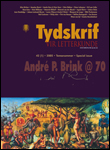Anderkant die stilte (André P. Brink) en die verwerking van trauma
DOI :
https://doi.org/10.4314/tvl.v42i1.29696Mots-clés :
André P. Brink, trauma, healing, truth, reconciliation, The Other Side of Silence (Anderkant die stilte)Résumé
Quite a few Afrikaans literary critics have contended that the telling of stories can play a significant role in dealing with a traumatic past. H.P. van Coller (1997) spoke in this regard of "The Truth and Reconciliation Committee" in Afrikaans literature, based on salient traits in contemporary Afrikaans literary texts. In stark contrast to these critics Philip John (2000) insisted that it is naïve and shortsighted to expect (literary) texts to heal traumas. He instead argues for the reshaping (Aufarbeitung) of the past. John also maintains that "repressor", "repressed" and "guilt" are fuzzy concepts and open to abuse. This article takes issue with John. It is stated that narrative accounts of trauma can be therapeutic and that terms like "repressor" and "repressed" are often necessary in a psychological healing process. Actantial roles (as described by concepts such as "protagonist" and "antagonist"; "repressor" and "repressed") are necessary prerequisites for any narrative. According to Ernst van Alphen (1999) trauma is evoked by the incapacity to narrate a traumatic past. Lastly it is asserted that stories (and literature) are important "in a time of cholera" and as in the case of, provide an individual and a collective, the means for survival. These theoretical andphilosophical arguments are illustrated with reference to Anderkant die stilte (2002) by André P. Brink.
Téléchargements
Références
...
Téléchargements
Publiée
Numéro
Rubrique
Licence
(c) Copyright Tydskrif vir Letterkunde 2005

Ce travail est disponible sous licence Creative Commons Attribution - Partage dans les Mêmes Conditions 4.0 International.


 https://orcid.org/0000-0001-6465-6584
https://orcid.org/0000-0001-6465-6584


.png)